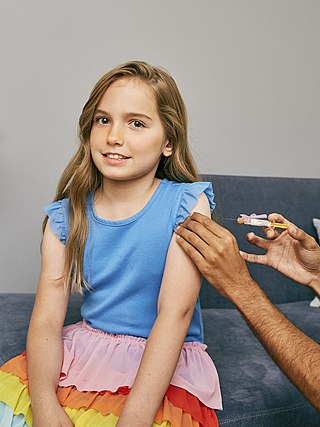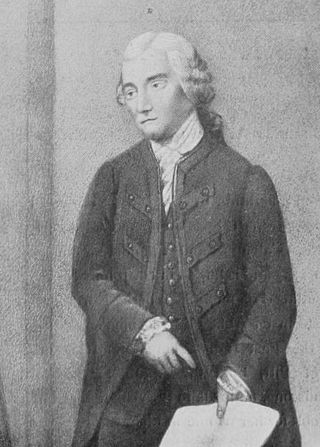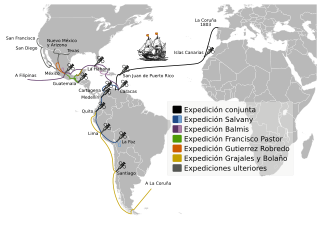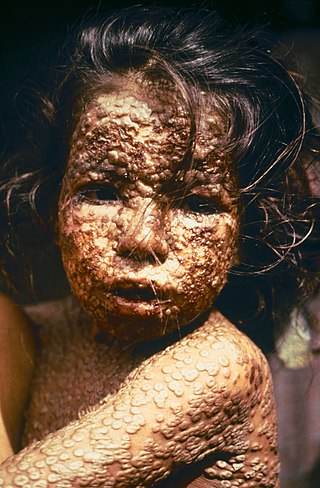
Edward Jenner was an English physician and scientist who pioneered the concept of vaccines and created the smallpox vaccine, the world's first vaccine. The terms vaccine and vaccination are derived from Variolae vaccinae, the term devised by Jenner to denote cowpox. He used it in 1798 in the title of his Inquiry into the Variolae vaccinae known as the Cow Pox, in which he described the protective effect of cowpox against smallpox.

Vaccination is the administration of a vaccine to help the immune system develop immunity from a disease. Vaccines contain a microorganism or virus in a weakened, live or killed state, or proteins or toxins from the organism. In stimulating the body's adaptive immunity, they help prevent sickness from an infectious disease. When a sufficiently large percentage of a population has been vaccinated, herd immunity results. Herd immunity protects those who may be immunocompromised and cannot get a vaccine because even a weakened version would harm them. The effectiveness of vaccination has been widely studied and verified. Vaccination is the most effective method of preventing infectious diseases; widespread immunity due to vaccination is largely responsible for the worldwide eradication of smallpox and the elimination of diseases such as polio and tetanus from much of the world. However, some diseases, such as measles outbreaks in America, have seen rising cases due to relatively low vaccination rates in the 2010s – attributed, in part, to vaccine hesitancy. According to the World Health Organization, vaccination prevents 3.5–5 million deaths per year.

A vaccine is a biological preparation that provides active acquired immunity to a particular infectious or malignant disease. The safety and effectiveness of vaccines has been widely studied and verified. A vaccine typically contains an agent that resembles a disease-causing microorganism and is often made from weakened or killed forms of the microbe, its toxins, or one of its surface proteins. The agent stimulates the body's immune system to recognize the agent as a threat, destroy it, and recognize further and destroy any of the microorganisms associated with that agent that it may encounter in the future.

Cowpox is an infectious disease caused by the cowpox virus (CPXV). It presents with large blisters in the skin, a fever and swollen glands, historically typically following contact with an infected cow, though in the last several decades more often from infected cats. The hands and face are most frequently affected and the spots are generally very painful.

The smallpox vaccine is the first vaccine to have been developed against a contagious disease. In 1796, British physician Edward Jenner demonstrated that an infection with the relatively mild cowpox virus conferred immunity against the deadly smallpox virus. Cowpox served as a natural vaccine until the modern smallpox vaccine emerged in the 20th century. From 1958 to 1977, the World Health Organization (WHO) conducted a global vaccination campaign that eradicated smallpox, making it the only human disease to be eradicated. Although routine smallpox vaccination is no longer performed on the general public, the vaccine is still being produced to guard against bioterrorism, biological warfare, and mpox.

John Zephaniah Holwell was a surgeon, an employee of the British East India Company, and a temporary Governor of Bengal (1760). He was also one of the first Europeans to study Indian antiquities and was an early advocate of animal rights and vegetarianism.

Immunization, or immunisation, is the process by which an individual's immune system becomes fortified against an infectious agent.
In biology, immunity is the state of being insusceptible or resistant to a noxious agent or process, especially a pathogen or infectious disease. Immunity may occur naturally or be produced by prior exposure or immunization.

The Royal Philanthropic Vaccine Expedition, commonly referred to as the Balmis Expedition, was a Spanish healthcare mission that lasted from 1803 to 1806, led by Dr Francisco Javier de Balmis, which vaccinated millions of inhabitants of Spanish America and Asia against smallpox. The vaccine was actually transported through children: orphaned boys who sailed with the expedition.
Artificial induction of immunity is immunization achieved by human efforts in preventive healthcare, as opposed to natural immunity as produced by organisms' immune systems. It makes people immune to specific diseases by means other than waiting for them to catch the disease. The purpose is to reduce the risk of death and suffering, that is, the disease burden, even when eradication of the disease is not possible. Vaccination is the chief type of such immunization, greatly reducing the burden of vaccine-preventable diseases.
James Jurin FRS FRCP was an English scientist and physician, particularly remembered for his early work in capillary action and in the epidemiology of smallpox vaccination. He was a staunch proponent of the work of Sir Isaac Newton and often used his gift for satire in Newton's defence.

Smallpox was an infectious disease caused by variola virus, which belongs to the genus Orthopoxvirus. The last naturally occurring case was diagnosed in October 1977, and the World Health Organization (WHO) certified the global eradication of the disease in 1980, making smallpox the only human disease to have been eradicated to date.
The history of smallpox extends into pre-history. Genetic evidence suggests that the smallpox virus emerged 3,000 to 4,000 years ago. Prior to that, similar ancestral viruses circulated, but possibly only in other mammals, and possibly with different symptoms. Only a few written reports dating from about 500 AD to 1000 AD are considered reliable historical descriptions of smallpox, so understanding of the disease prior to that has relied on genetics and archaeology. However, during the 2nd millennium AD, especially starting in the 16th century, reliable written reports become more common. The earliest physical evidence of smallpox is found in the Egyptian mummies of people who died some 3,000 years ago. Smallpox has had a major impact on world history, not least because indigenous populations of regions where smallpox was non-native, such as the Americas and Australia, were rapidly and greatly reduced by smallpox during periods of initial foreign contact, which helped pave the way for conquest and colonization. During the 18th century the disease killed an estimated 400,000 Europeans each year, including five reigning monarchs, and was responsible for a third of all blindness. Between 20 and 60% of all those infected—and over 80% of infected children—died from the disease.

Progressive vaccinia is a rare cutaneous condition caused by the vaccinia virus, characterized by painless but progressive necrosis and ulceration.
Variolation was the method of inoculation first used to immunize individuals against smallpox (Variola) with material taken from a patient or a recently variolated individual, in the hope that a mild, but protective, infection would result. Only 1–2% of those variolated died from the intentional infection compared to 30% who contracted smallpox naturally. Variolation is no longer used today. It was replaced by the smallpox vaccine, a safer alternative. This in turn led to the development of the many vaccines now available against other diseases.
John Fewster was a surgeon and apothecary in Thornbury, Gloucestershire. Fewster, a friend and professional colleague of Edward Jenner, played an important role in the discovery of the smallpox vaccine. In 1768 Fewster realized that prior infection with cowpox rendered a person immune to smallpox.
The Massachusetts smallpox epidemic or colonial epidemic was a smallpox outbreak that hit Massachusetts in 1633. Smallpox outbreaks were not confined to 1633 however, and occurred nearly every ten years. Smallpox was caused by two different types of variola viruses: variola major and variola minor. The disease was hypothesized to be transmitted due to an increase in the immigration of European settlers to the region who brought Old World smallpox aboard their ships.
Onesimus was an African man who was instrumental in the mitigation of the impact of a smallpox outbreak in Boston, Massachusetts. His birth name is unknown. He was enslaved and, in 1706, was given to the New England Puritan minister Cotton Mather, who renamed him. Onesimus introduced Mather to the principle and procedure of the variolation method of inoculation to prevent the disease, which laid the foundation for the development of vaccines. After a smallpox outbreak began in Boston in 1721, Mather used this knowledge to advocate for inoculation in the population. This practice eventually spread to other colonies. In a 2016 Boston magazine survey, Onesimus was declared one of the "Best Bostonians of All Time".

In 1721, Boston experienced its worst outbreak of smallpox. 5,759 people out of around 10,600 in Boston were infected and 844 were recorded to have died between April 1721 and February 1722. The outbreak motivated Puritan minister Cotton Mather and physician Zabdiel Boylston to variolate hundreds of Bostonians as part of the Thirteen Colonies' earliest experiment with public inoculation. Their efforts would inspire further research for immunizing people from smallpox, placing the Massachusetts Bay Colony at the epicenter of the Colonies' first inoculation debate and changing Western society's medical treatment of the disease. The outbreak also altered social and religious public discourse about disease, as Boston's newspapers published various pamphlets opposing and supporting the inoculation efforts.
The European colonisation of Australia, was accompanied by epidemic diseases to which the original inhabitants had little resistance. Colds, influenzas, tuberculosis (TB), and measles were major killers. Such diseases devastated Aboriginal populations, weakened their cultures, and often left them in no position to resist the newcomers. Within perhaps as little as six months of the arrival of the First Fleet, venereal disease was already a serious problem for local Aboriginal peoples; but the first disease to produce a major fall in the Aboriginal population around Sydney was the 1789 outbreak, some 16 months after the Fleet arrived, of what Governor Phillip and others referred to as “smallpox”. Watkin Tench, a captain in the Marines, wrote that, "Pustules, similar to those occasioned in the smallpox, were thickly spread on the bodies; but how a disease to which our former observations had led us to suppose them strangers could at once have introduced itself, and spread so widely, seemed inexplicable."











